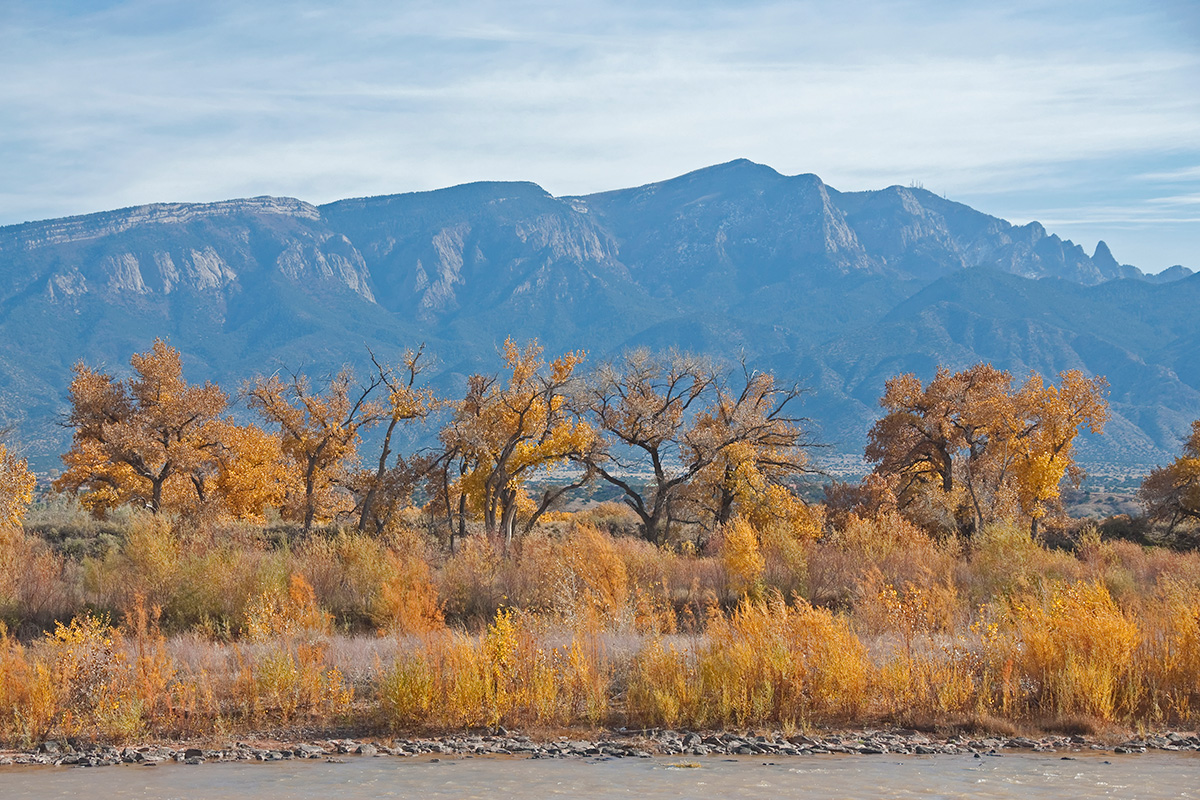Turning east onto U.S. 550, I see the old cottonwood trees that line El Rio Grande, river and lifeblood of the peoples of my region. Their leaves have turned hues of yellow and orange. I am headed to la casa de mis padres, the home of my parents. As I cross the bridge, I see the beautiful Sandia Mountains, the crest ablaze in color.
My querencia strikes, and feeling a sense of home, the place from which I draw my strength, I tune my iPod Nano to “Una casa de adobe” by Los Blue Ventures. Pulling up to a stoplight, Sandia Mountain looms before me. I think about how this large landmark turns dark-pink at sunset, resembling a watermelon cut in half. In my county, we orient ourselves in reference to the mountain; as I continue toward it, I reflect on my small town in central New Mexico. I grew up in Bernalillo, which was founded in the 1600s and just surpassed 10,000 residents in 2010. What a blessing to call this place home, just as my ancestors did before me.
This time of year is special. Autumn in Bernalillo, like in other parts of New Mexico, is enchanting and exhilarating. As the air turns crisper, the cherished scent of roasted green chile fills the air. This smell, like the smell of fresh rain, is like no other in this high-desert landscape.
As I turn north onto NM 313, I think about Bernalillo’s ritual and agricultural calendars that come to an end in early August, only to begin anew. This past August, we celebrated the 324th annual Fiesta de San Lorenzo by performing the Matachines dance. I completed my annual promesa (promise) as a Matachines dancer, a very fulfilling act as it’s such a beautiful tradition.

We ask for blessings and in turn we participate in whatever way we can, whether by dancing, praying, playing violin or guitar, feeding the community, or having the statue of the saint reside in the home for the year, along with many other ways that people make promesas. We also thank God and San Lorenzo for his intercession, for the blessings we have already received. Our promise ties us to the earliest occupation by the Spanish in this beautiful valley. Our ritual and agricultural calendars thus end and begin with the conclusion of la fiesta.
By then the harvest is in full swing, with the community celebrating the staple crops of corn, beans, squash, tomatoes, and, most importantly, chile. We roast and peel Hatch green chiles to prepare for the winter months. We hang them up in strung ristras, allowing them to dry in the cooler autumn air, thus turning red for use in the chile paste that is crucial to so many of our dishes. We make tamales and posole and other essentials of nuevomexicano cuisine in the fall and winter. For dessert we have biscochitos (spiced cookies) and natillas (custard).
A beloved autumn tradition of our region is El Día de los Muertos, or the Day of the Dead on November 1. Practiced in many different ways in the greater Southwestern United States and Mexico, Día de los Muertos is devoted welcoming the return of those who have departed us here on Earth.

This year, I am excited to build my own ofrenda, or offering altar, for my querida abuelita (grandmother), who left us suddenly last year, my other grandparents, and all of those who have left us. Que descansen en paz—rest in peace. We erect ofrendas in the home, decorated with their favorite foods and earthly possessions, so that we can celebrate their lives, eat, and be happy.
During the autumn months, nuevomexicanos traditionally travel to a neighboring Pueblo. This year I will visit some dear friends in Kewa Pueblo, where guests are graciously given specialties such as cookies, pies, and bread made in outdoor ovens called hornos.
The unique tradition of Oremos, Oremos (“let us pray”), is also held around this time, reflecting a syncretic blending of Pueblo and nuevomexicano traditional cultures and calendars. Guests visit Pueblo homes, knock on doors, recite the “Oremos” chant, or any prayer, and are received by the resident with snacks, treats, and Pueblo delicacies.
Autumn in Bernalillo is a time when sights, smells, sounds, and feelings mix to create a powerful sense of querencia, a yearning for all things cultural. After all, it is who we are, and it is what makes up our collective identity. It is also when we feel the greatest attachment to the place we call home. We are proud to celebrate time-tested traditions that have survived over the centuries. Los Matachines, Oremos, Día de los Muertos, the green chile harvest, and our beloved Sandia Mountains are reminders of how awe-inspiring this time of year is.

As I arrive at my parents’ house, I can’t help but pause. This home, una casa de adobe, was constructed by my great-grandparents. A small American flag placed in a flower pot adjacent to the front door wafts through the crisp, cool air. I walk in and greet my parents.
“What’s for dinner?” I ask.
To my heart’s content, my mother responds, “Posole and red chile.”
Joseph A.J. Moreno is a PhD candidate at the University of New Mexico focusing on nuevomexicano language and cultural revitalization. He is also a dancer in Bernalillo’s Matachines dance tradition.


